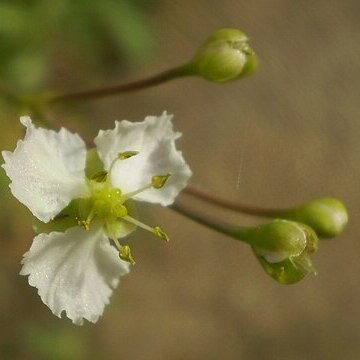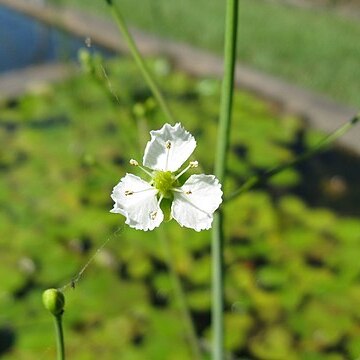Glabrous. Leaves floating, broad-ovate to broad-elliptic or suborbicular, 2.5-6 cm long measured along the midrib, base deeply cordate with broadly rounded basal lobes, apex obtuse, in smaller specimens sometimes broad-acute; nerves 13-17, connected by very numerous, straight, parallel, fine crossbar-veins, 1/3-1/2 mm spaced, ascending at 60°; petiole c. 25(-50) cm, with few lengthwise air-channels, prominently septate at distances of 4-8 mm when dry. Inflorescences few or one, peduncle hollow, with lengthwise air-channels, finely ribbed when dry, including the panicle c. 15 cm long. Panicle mostly shorter than the peduncle, pyramidal, branches and flowers on the branches regularly in subsequent whorls of 3, sometimes seemingly in whorls of 4-6 but then 1-3 pedicels represent really 1-flowered branches with each 3 bracts above the base of the 'pedicel'; each branch and pedicel sustained at the base by a membranous, acute, oblong-lanceolate bract, lower ones 1 cm long, subsequent ones gradually smaller. Pedicels 1.5-4 cm. Sepals elliptic, bluntly rounded, reMain ing erect, pale green with hyaline margin, c. 3.5-4.5 by 2-2.5 mm. Petals white, in bud elliptic, bluntly rounded, very thin, somewhat exceeding the sepals. Stamens 6, filaments white or pale yellow, broadened towards the base, persistent, 2-2.5 mm; anthers bright yellow, compressed, 1 by 1/3-1/2 mm. Carpels 5-8, not all developing into achenes, compressed, obovate, including the style 2-2.5 mm; style subterminal, c. 1-1.5 mm; stigma punctiform. Achene elliptic; laterally faintly compressed, dorsally with 3-5 longitudinal ribs, incl. style c. 3-4 mm long; exocarp spongy, brown, endocarp consisting of a layer of thick-walled sclerenchymatic, radial cells, each cell-wall inside provided with ribs. Seed c. 2 by 1 mm, pale brown.
More
Emergent perennial or annual with emergent and floating leaves. Mature leaves with petiole septa 2–4 mm apart when dry; blade broadly elliptic to suborbicular, 3.5–6.5 cm long, not pellucid-dotted;base deeply cordate with rounded basal lobes; apex obtuse; main veins 11–15; cross veins fine, parallel, at 60° to veins, 0.2–0.5 mm apart. Inflorescence pyramidal, c. 75 cm long; branches and flowers on branches mostly in whorls of 3; lower bracts 1 cm long, shorter upwards. Sepals elliptic, c. 3.5–4.5 mm long, remaining erect after anthesis, pale green with hyaline margin. Petals slightly longer than sepals. Stamens 6. Carpels 5–8, not all developing, c. 1 mm long. Achenes ellipsoid, faintly compressed, c. 3–4 mm long, with 3–5 smooth, dorsal, longitudinal ribs. Seeds c. 2 mm long, pale brown.
Rhizomes creeping. Petiole 5-100 cm; leaf blade ovate or elliptic, 2-10 × 1.5-7 cm, veins 9-15, base cordate to deeply so, apex obtuse. Scapes erect or not, 30-125 cm high; inflorescences paniculate, 20-35 cm. Flowers 3-verticillate; pedicels 2.5-4 cm. Sepals persistent, ovate, 3.5-5 × 2-3 mm. Petals ovate, larger than sepals. Stamens 6. Carpels 5-10, laterally compressed; style 2(-4) mm, slender. Fruitlets obovoid, ca. 3 × 2 mm, with 3-5 longitudinal ribs abaxially and an erect beak. Fl. and fr. May-Oct. 2n = 22*.
A herb. The leaf stalk is 5-100 cm long. The leaves are oval and 2-10 cm long by 1.5-7 cm wide. They are heart shaped at the base. The flowers are in a group.



